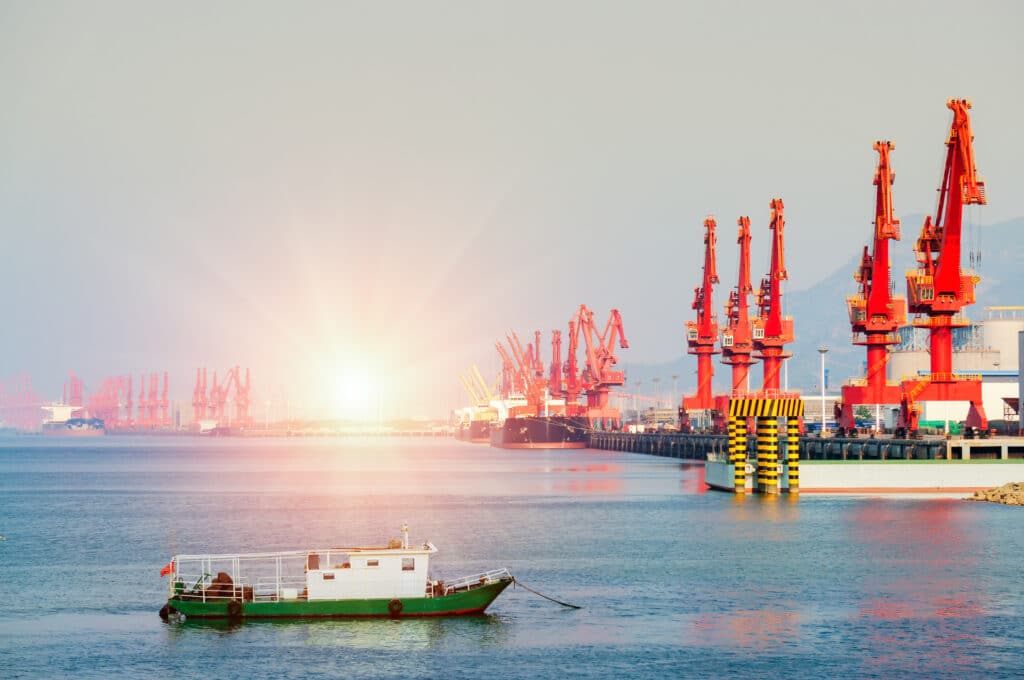Chinese investments of Kazakhstan Railway: What has company achieved investing $100 million in terminal on the shore of Yellow Sea?
A joint Kazakhstan-China venture in Lianyungang Port is celebrating its tenth anniversary this year. Kursiv.media has assessed the project’s efficacy, along with insights from those who stood behind the initiative: Kazakhstan Railways and the Ministry of Transport of Kazakhstan.

White sea foam in the Yellow Sea
The city of Lianyungang, stretching along the shore of the Yellow Sea in the Chinese province of Jiangsu, was chosen by Kazakhstan Railways (KTZ) for its strategic significance. This agglomeration, with a population of 4.7 million people, is the starting point for the so-called New Silk Road, often referred to as the New Eurasian Land Bridge. This motto is even inscribed on a wall in Lianyungang Port. About 10,900 kilometers to the west lies the endpoint of this route — the Dutch city of Rotterdam.
Lianyungang is among the top 10 Chinese and top 50 international seaports in terms of cargo turnover. During the first nine months of 2024, it processed 230 million tons of cargo, reflecting a 9% increase over the previous year. This includes 4.4 million TEU (twenty-foot equivalent units), a rise of 13% year-on-year. The port is home to numerous foreign companies, including Dedola Global Logistics, a logistics company from California and Caltex Youqi Limited Company, a subsidiary of Chevron, which trades fuel in the Asia-Pacific region and the Middle East under the Caltex brand.
Lianyungang China-Kazakhstan International Logistics Co. is controlled by KTZ Express (51%), a subsidiary of Kazakhstan Railways, and Lianyungang Port Holding Group Co., Ltd (49%), an entity under the administration of the city of Lianyungang.
The first news about the project appeared in 1995 when Kazakhstan and China signed an agreement concerning cargo freight through Lianyungang Port. However, the two sides would launch the project only in 2013 when Chinese President Xi Jinping visited Astana for negotiations. That year, KTZ and the Port of Lianyungang agreed to start construction of a logistical terminal and share responsibility for managing the asset.
The total amount of Kazakhstani investments in cargo transshipment was estimated at $100 million. By allocating these funds, the country aimed to establish maritime infrastructure to reduce the deadlines for cargo supply from the Asia-Pacific to Kazakhstan and vice versa, cutting the delivery time from 45 days to 15 days.
As of 2023, the terminal spans a floor size of 220,000 square meters and has a loading and off-loading capacity of 410,000 TEU. The first stage of the project, with a capacity of 250,000 TEU per year, was realized in 2014. The terminal provides services not only to Kazakhstani cargo shippers and receivers but also to many other clients from Central Asia, facilitating the transit of a wide range of products like metals, flour, cotton yarn, construction materials and cars through China. In June 2024, a new railway route stretching from Korea to Uzbekistan via China and Kazakhstan was introduced.
The joint venture with the Chinese port is not the only project run by KTZ and the Port of Lianyungang. In its annual report in 2017, the railway company revealed that the Port of Lianyungang and COSCO Shipping, another Chinese company, entered the capital of KTZE-Khorgos Gateway along with KTZXXX. In May 2024, KTZ and the Chinese port announced plans to create another container hub in the port of Aktau (Kazakhstan), designed to serve as a hub for container shipments for countries in the Caspian Sea region and Central Asia.
Conversion to 20 pounds
Even though the Lianyungang project by KTZ has been operating for ten years, its output remains quite modest. In 2023, the Ministry of Transport of Kazakhstan reported that the terminal processed 243,000 TEU in container shipments, which means it was loaded to just 59% of its overall capacity.
Has the port become a gateway to the Asia-Pacific for exporters from Kazakhstan and Central Asia? According to the Ministry of Transport, in 2023, the terminal received 21,000 TEU from Central Asia, including 14,000 TEU from Kazakhstan, mainly consisting of ferroalloys, wheat, offal, asbestos and gold ore concentrates. Over the first seven months of 2024, the terminal received 16,000 TEU from Central Asia, including 11,000 TEU from Kazakhstan.
The port still has significant potential in terms of import capacity. According to KTZ, over the first seven months of the year, the Port of Lianyungang sent more than 45,000 containers to Central Asia, reflecting a 22.4% increase over the same period last year.
The financial results of the joint venture provide a good reflection of its production outcomes. Since the annual reports of KTZ Express for 2022 and 2023 were unavailable for review or download on the Ministry of Finance website, the only reliable source of information regarding the financial status of the Chinese asset of the national railway company is the KTZ Express report for 2021. In this report, the company revealed key indicators of its subsidiaries, including the Kazakhstan-China International Company in Lianyungang.
In 2021, the company reported $71 million in overall assets and $68 million in net assets. However, due to asset depreciation of $22.9 million in 2020, the book value of the asset was fixed at $6.7 million. In 2021, the company reported $7.7 million in revenue (+3% year-on-year) and $383,821 in net profit (a tenfold increase year-on-year).
When comparing the profitability of sales and assets in the disposal of the joint venture to the entire national railway company at the end of 2021, it is evident that the rate is much higher for KTZ than for the joint venture: 9% vs. 5%, respectively, for sales and 3% vs. 0.6%, respectively, for assets.
Ministry of Transport’s perspective on project success
The Ministry of Transport describes the project as successful:
«We are observing a positive dynamic in transshipment, which boosts the profitability of the joint venture and proves our investments to be justified.»
«Over ten years of operation, the terminal has become an international platform for transit shipments, warehouse logistics and trade between Central Asia, China and the Asia-Pacific,» KTZ stated.
The railway company expects that the terminal will process up to 320,000 TEU and 1,200 railway trains within the next five years.
«The existing capacity and infrastructure of the terminal enable it to effectively process the current amount of cargo. Given that the designed capacity of the terminal is 410,000 TEU, it still has plenty of capacity for its operations. This means that no new investments are required to boost the terminal’s capacity. From a financial point of view, it’s fully viable. Thanks to stable revenue and a sustainable operational model, there is no need for additional investments in the near future.»
Not just the Kazakhstani approach
Uzbekistan, a landlocked country surrounded by landlocked neighbors (Liechtenstein is the only other example), also has the intention to expand its export infrastructure. Last year, Uzbektextileprom, an association of textile companies in Uzbekistan, announced its plan to create a logistical terminal in the Poti Sea Port in Georgia to facilitate its exports to North America and Japan. However, there have been no further reports regarding the project, while the Poti Free Industrial Zone does not disclose its participants.
In early September, Davron Vakhabov, chair of the Chamber of Commerce and Industry of Uzbekistan and Ali Bin Abdullatif Al Misned, a board member of the Qatar Chamber of Commerce & Industry, discussed the idea of opening a distribution center at Hamad International Airport in Qatar. The new hub is expected to distribute goods from Uzbekistan among the Gulf nations. As highlighted by the Uzbekistani chamber, if opened, the new fulfillment center will stock textiles, leather, silk, food, electrotechnical, chemical, pharmaceutical, perfume, cosmetic, automotive and metallurgical products, as well as jewelry, furniture and construction materials.
Of course, supporting export infrastructure abroad is on the agenda for many other countries, not just landlocked ones. In August, Kommersant, a Russian business media outlet, reported on an updated version of the national project in Russia called «International Cooperation and Export.» While presenting the project designed to last until 2030, Russian Minister of Industry and Trade Anton Alikhanov pointed to a new federal initiative, «The Development of International Export Infrastructure,» as a new component of the aforementioned national project. Under this sub-project, the Russian government plans to support industrial development zones, seaport projects and logistical hubs abroad.
«Similar projects are already underway in Uzbekistan and Kazakhstan. In fact, this upgrade of logistics and geography of supplies needs new infrastructural projects. As First Deputy Prime Minister of Russia Denis Manturov reported earlier, thirteen infrastructural facilities abroad are expected to be built by 2030, along with incentives for the use of crucial international transport and logistical routes such as the North-South corridor towards South America and Africa. This is partly necessary to alleviate the burden on the most popular existing routes,» Kommersant reported.

